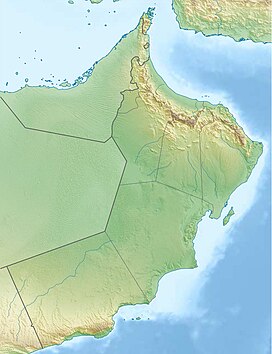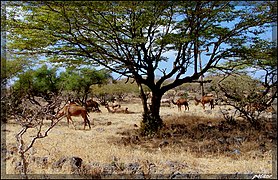geo.wikisort.org - Mountains
The Dhofar Mountains (Arabic: جِبَال ظُفَار, romanized: Jibāl Ẓufār) are a mountain range in the southeastern part of the Arabian Peninsula. In a broad sense, they extend from Dhofar Governorate in Oman to Hadhramaut Governorate in Yemen, and are located between the Hajar in the northern part of Oman, and the Sarawat in the western part of Yemen.[1] Otherwise, the range in the eastern part of Yemen, particularly near Mukalla, is referred to as the "Hadhramaut"[2] or "Mahrat".[1]
| Dhofar Mountains | |
|---|---|
 The area of Salalah during the annual Khareef season | |
| Highest point | |
| Coordinates | 17.1°N 54.0°E |
| Naming | |
| Native name | جِبَال ظُفَار (Arabic) |
| Geography | |
| Country | |
| Region | Asia |
Geology

Al-Qara Mountains (Arabic: جِبَال ٱلْقَارَة, romanized: Jibāl Al-Qārah) are a subrange of the Dhofar,[1] Jabal Al-Qamar (Arabic: جَبَل ٱلْقَمَر) and Jabal Samhan are part of this range,[3][4] The latter is the highest point at about 2,100 m (6,900 ft).[5]
Wildlife
The Arabian leopard thrives here, particularly in Jabal Samhan Nature Reserve.[3][6]
The Asiatic cheetah used to occur in this region. Oman's last known cheetah was killed near Jibjat in 1977 (Harrison, 1983).[7]
In December 2018, a Schokari sand racer was spotted in a mountain in this region.[8]
Gallery
- Ayn Jarziz with the greenery typical of the Kharīf (autumn)
- Camels in the vicinity of Salalah
- Camels walking in the rugged landscape, outside the Kharīf season
 Camel ride in 1948
Camel ride in 1948- Claimed to be the mosque where the remains of Ayyub (Job) are located[9]
- Trees and camels
- Landscape of Al-Qarah Mountains
See also
- Geography of Oman
- Hills of Masirah Island
- South Arabia
- South Arabian fog woodlands, shrublands, and dune
- Southwestern Arabian foothills savanna
References
- Cavendish, Marshall (2006). "I: Geography and climate". World and Its Peoples: The Middle East, Western Asia, and Northern Africa. Cavendish Publishing. pp. 8–22. ISBN 0-7614-7571-0.
- Scoville, Sheila A. (2006). Gazetteer of Arabia: a geographical and tribal history of the Arabian Peninsula. Vol. 2. Akademische Druck- u. Verlagsanstalt. pp. 117–122. ISBN 0-7614-7571-0.
- Spalton, J. A. & Al-Hikmani, H. M. (2006). "The Leopard in the Arabian Peninsula – Distribution and Subspecies Status" (PDF). Cat News (Special Issue 1): 4–8.
- Ghazanfar, Shahina A.; Fisher, Martin (2013-04-17). "11–13". Vegetation of the Arabian Peninsula. Sultan Qaboos University, Muscat, Oman: Springer Science & Business Media. pp. 270–345. ISBN 978-9-4017-3637-4.
- "Samhan Mountain". Ministry of Tourism, Sultanate of Oman. Retrieved 2019-01-14.
- Spalton, J. A.; Hikmani, H. A.; Willis, D.; Said, A. B. (2006), "Critically Endangered Arabian leopards Panthera pardus nimr persist in the Jabal Samhan Nature Reserve Oman", Oryx, ORYX-LONDON, 40 (3): 287, doi:10.1017/S0030605306000743
- Nowell, K., Jackson, P. (1996). "Asiatic cheetah". Wild Cats: Status Survey and Conservation Action Plan (PDF). Gland, Switzerland: IUCN/SSC Cat Specialist Group. pp. 41–44. ISBN 2-8317-0045-0.
{{cite book}}: CS1 maint: uses authors parameter (link) - "One of the fastest snakes caught on camera". The Times of Oman. 2018-12-23. Retrieved 2018-12-31.
- "Tomb of Job near Salalah". www.usna.edu. Retrieved 2018-12-24.
External links
- Wildlife: Snapshots from Dhofar
- CNN explores Oman's Dhofar Mountains and the critically endangered Arabian leopard (YouTube)
- The Dhofar Mountains in Oman. Samhan mountain by Salim Al Barwani
- 2 Discover Dhofar Mountains 2016 #GoPro
- رحلة إعادة إكتشاف جبال ظفار Discover Dhofar Mountains 2015 #GoPro
На других языках
[de] Dschabal Dhufar
Dschabal Dhufar (auch: Dschabal al-Qarah, en.: Dhofar Mountains, arabisch جبال ظفار, DMG Ǧibāl Ẓufār oder arabisch جبال القارة Ǧibāl al-Qāra) ist die Bezeichnung für eine Gebirgskette im südöstlichen Teil der Arabischen Halbinsel. Der gesamte Gebirgszug erstreckt sich vom Gouvernement Dhofar im Oman im Nordosten bis ins Gouvernement Hadramaut im Jemen im Südwesten. Im Norden erhebt sich im Anschluss daran dass Hadschar-Gebirge und im Süden das Sarawat-Gebirge im Westen des Jemen.[1] Teilweise wird das Gebirge im Osten des Jemen, vor allem in der Nähe von al-Mukalla als Hadramaut bezeichnet,[2] oder als „Mahrat“.[1]- [en] Dhofar Mountains
Другой контент может иметь иную лицензию. Перед использованием материалов сайта WikiSort.org внимательно изучите правила лицензирования конкретных элементов наполнения сайта.
WikiSort.org - проект по пересортировке и дополнению контента Википедии







![Claimed to be the mosque where the remains of Ayyub (Job) are located[9]](http://upload.wikimedia.org/wikipedia/commons/thumb/5/57/Jebel_Qara_-_moschea_presso_la_tomba_di_Giobbe_-_panoramio.jpg/140px-Jebel_Qara_-_moschea_presso_la_tomba_di_Giobbe_-_panoramio.jpg)





